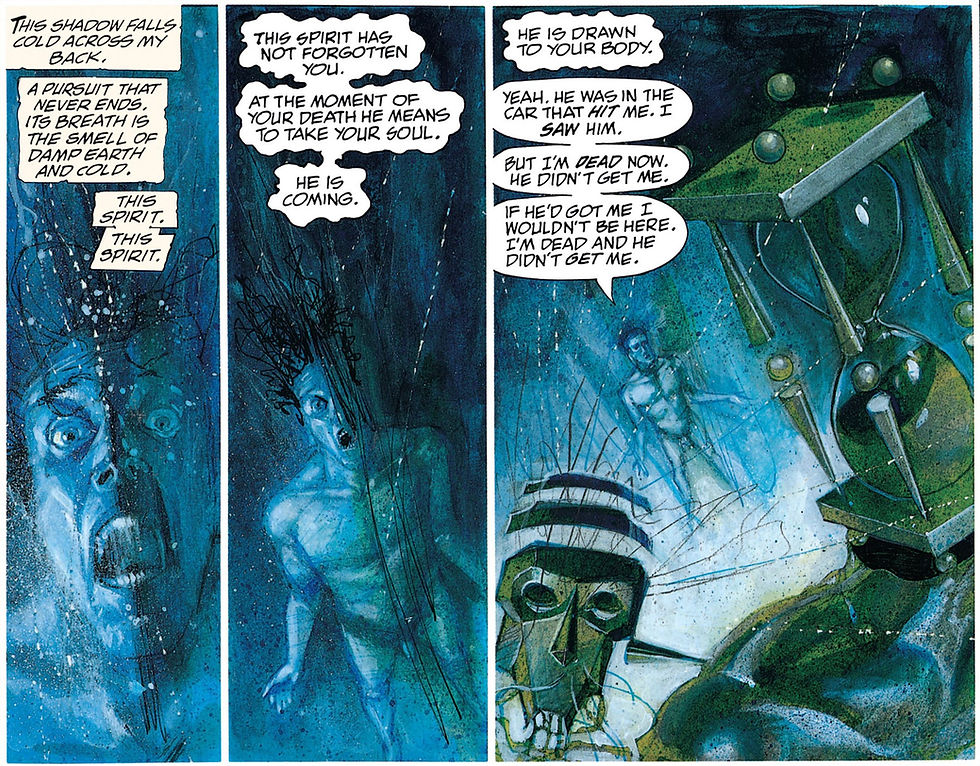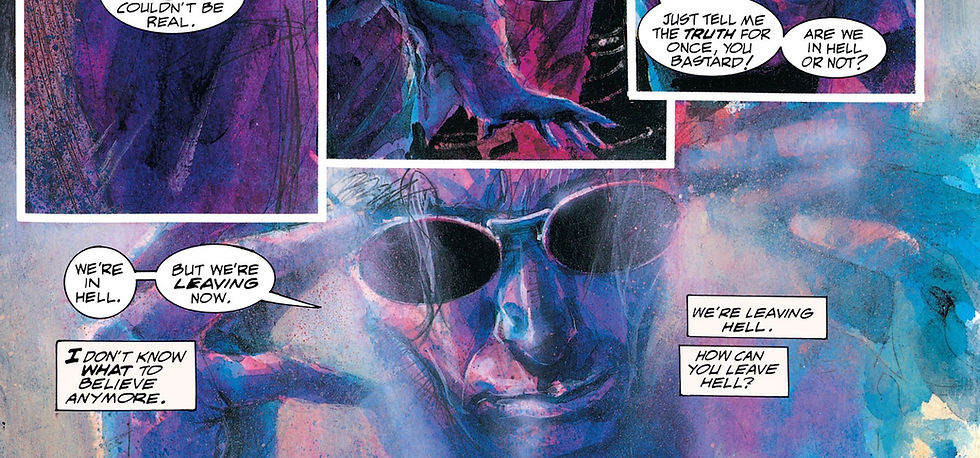POST 188 --- KID ETERNITY BY GRANT MORRISON
- Scott Cresswell
- Aug 21, 2022
- 7 min read
God, how I miss the innocent days of old comics. Although the Golden Age of the thirties and forties may have been darker and blunter in tone than the fifties and sixties, the overall mood of comics at the time was bright and hopeful. Superheroes dominated the market as Superman and Batman unleashed the new craze that was to define the medium forever. Countless heroes appeared in the war years, some of whom are remembered fondly, and others forgotten, but recalled by hardcore fans with just as much fondness. One of those is Kid Eternity. Created in Hit Comics 25 for Quality Comics (a company who DC absorbed in the 1950s), Kid Eternity focused on a regular boy who is killed during the Second World War decades before his time. To compensate, some goldy heaven-like figure resurrects the boy and gives him the power to bring any real or fictional being to life. From there, the comics write themselves; the boy uses his powers to do good. Over time, Kid Eternity was forgotten and dismissed as a figure from the past, but what if he were to come back? And more to the point, how could such a cheery character be reinvented for dark DC Comics of 1990s Vertigo. The answer, unsurprisingly, was with Grant Morrison.
Kid Eternity (vol 2) 1-3 was published from April to November 1991 (very

schizophrenic!). It was written by Grant Morrison with art by Duncan Fegredo. Published under DC’s Vertigo imprint, I’ve read this miniseries in its trade paperback.
By 1991, Grant Morrison had got the reputation of something of a reinventor. Four years earlier, he had relaunched Animal Man, a bizarre superhero from the 1960s that most would dismiss as an old has-been. However, Animal Man (vol 1) became an instant bestseller, and soon afterwards Grant Morrison kicked new life into the Doom Patrol, another sixties creation. Kid Eternity is certainly an idea/project that Morrison would be involved in. After all, with all its apparent charm and gimmicks, Kid Eternity looked like something Morrison could play around with, update, and revolutionise in a memorable way. However, if you’ve read Animal Man or Doom Patrol and loved them as much as I did, Kid Eternity’s style will leave you feeling different. Remember, this was written in the 1990s, a time when Neil Gaiman’s Sandman, influenced by Alan Moore’s Swamp Thing, fundamentally changed the idea of the gothic DC titles, later to be known as Vertigo. Ignoring the highly questionable art, the story here is very much what Grant Morrison does later in the Invisibles.
That said, Kid Eternity immediately grabs the reader’s attention with the first few pages. The story begins violently as a man is wheeled into hospital with severe injuries and the prospect of death. Like most Grant Morrison stories, this is a moment that takes place much later in the story. For now, we are thrown back into the past and things get confusing. Every single person at a party is murdered bloodily by a strange set of creatures on the hunt. What are they looking for? Kid Eternity obviously! It turns out that Kid Eternity, now a gothic and spiky-looking character who reminds me of a mixture of Death from the Sandman and Starman by James Robinson, has been hiding in the head of Jerry Sullivan, a failing comedian. The relationship between these two, while littered with pretentiousness and dialogue that only a lunatic can understand, is quite enjoyable as their differences make for some mildly entertaining scenes. In short to summarise the plot, Kid Eternity is being hunted by the Shichiriron, a villainous group who can occupy inanimate objects with the aim to capture the hero and kill anyone close to him. Already, even though I cannot claim to have read any previous Kid Eternity stories, the character is radically different and virtually unrecognisable. There is little trace of any innocence or joy for that matter. At least when Morrison revived Animal Man, it was different but the core of the character it was about was intact. Here, Kid Eternity might as well be another character with a similar concept behind it. Either way, the first issue of this miniseries is full of pretentious crap that is honestly a chore to read. Morrison tries too hard to make Kid Eternity both clever and mysterious. In the end, even if the reader tries deeply to engage with the plot, they get hugely disheartened and give up. The writer does not help the reader understand anything. Things do improve towards the end of the first issue, where Kid Eternity’s origin is revealed (and it isn’t too dissimilar to what it was before) and his link with a strange Mr Keeper is introduced. He is mentioned several times throughout as a guiding light for the hero. From there, things do get more interesting as Kid Eternity enlists the help of Jerry Sullivan. The reasoning is never clear, and even if it is, it is disguised by vague and pretentious dialogue. However, the first issue ties things up nicely when Kid Eternity tells Jerry that he must die and go to hell to help him defeat the Shichiriron. Therefore, Kid Eternity arranges the car crash which lands Jerry in hospital; he is the dying man at the start. I really like this revelation, and there is something quite chilling about the star character watching himself fade into death and try to deal with that change. For Kid Eternity, that transition means nothing since he has done it before, but at least it makes things interesting. Overall, the first issue can be readable and there is some evidence of a coherent story. When it is understandable, it’s above average. When it’s not, it’s unreadable.
Sadly, issues two and three must be included together as both are dreary terrible pieces of comic book reading which I frankly found both boring and unintelligible. So, Kid Eternity and Jerry head to hell. Beforehand, Jerry is met at the gates of the afterlife by the same being who sent Kid Eternity back to life years before. Morrison then throws another of his confusing and ranting scenes at us about all sorts of unimportant events and visual stuff which ends up, once again, boring the reader.

With that out of the way, the second issue is home to loads of mundane and dull backstory with boring characters who add nothing to a story which, from the midpoint onwards, lacks any direction and frankly wastes my time. Throughout a story, a writer must develop the plot and continue to make it interesting. Here, Morrison quickly seems to forget about the story idea which sparked this miniseries and the second and third issues are a crazed and impossible-to-understand tale full of bizarre imagery. Sure, there may be a few interesting scenes featuring Kid Eternity and Jerry, who is forced to relive a trauma of his life to confront death, but the simple problem is that there is no engaging plot. It may sound strange but reading Kid Eternity is like being tortured with an unintelligible and boring old text with no drama. You begin reading with intrigue, but then as the pages pass and the dialogue fails to be memorable or stick in the mind, you lose interest and end up glancing at the dialogue and art just to finish the thing. After much filler, the second issue ends with Kid Eternity and Jerry meeting Mr Keeper, a huge monster in a cage. The relevance of this isn’t exactly clear, but Kid Eternity’s interests turn to who is in charge of hell since he left. The heroes quickly find the answer and the real villain is revealed to be a twisted and bizarre baby’s head in a jar. Reams of dialogue appear, and none of it means anything. The third issue is undeniably the worst and most unreadable of the three. As ever, there is no clarity, interest, or anything of real value going on, but this time, Morrison is too verbose and the concepts he introduces hit another level of bollocks. All you need to know is that the heroes win: Kid Eternity is safe from his evil chasers and Jerry is resurrected and placed back into reality. The story essentially leaves little changed. Jerry is back to life, and Kid Eternity continues with his life. Partly because of that, and all the other terrible elements showcased in the three issues, this miniseries leaves readers disappointed and unsatisfied. Morrison may have written just enough cohesive dialogue and words to make Jerry a fairly interesting character to explore, but since the writer doesn’t use him in any hugely interesting ways and his story ends normally without any change, it makes any development in his character pointless. As for Kid Eternity, his rebellious character does result in one or two amusing moments, but I find his misleading dialogue and background to become tiresome. There really aren’t any redeeming features when it comes to the characters. This is completely at odds with Morrison’s great skills as a writer. With Animal Man, he used a dull cast of characters from the 1960s and modernised them into an interesting and three-dimensional feature of the title. Here, Morrison certainly does change things, but beyond recognition to the point where all characters feel unfamiliar and alien. It’s a shame really. Like Morrison’s relaunch of Animal Man and Doom Patrol, Kid Eternity had potential. Morrison could have, if he had been sober when writing, revolutionised the original idea and made it modern while retaining its unique and original qualities. However, due to an incomprehensible style of writing and a plot that can hardly been worked out with any interest, Kid Eternity is one of Morrison’s worst stories. Therefore, it is a great missed opportunity.

Obviously, the original art of Kid Eternity during the colourful golden age looked quite basic, but appealing and bright. The storytelling was simple. However, this miniseries is home to some of the ugliest, but also unintelligible art ever published in a comic. It was the Vertigo craze to publish stories with art that looked messy and scratchy, as if drawn by a drug-addict. I’m not sure whether Duncan Fegredo can be considered one, but his sense of storytelling is woeful as it is often impossible to actually tell what if going on in some scenes. Morrison’s dialogue doesn’t help with that. The general image of the miniseries is a complete mess. I can just about see why some people would like the art of Dave McKean’s whose scratchy but imaginative style resonates with some. Here, Fegredo just makes a confusing and messy story even worse.
VERDICT
Overall, what else can I say? The story sucks and the art is abysmal. Read the originals if you want some fun.
Story: 0.5/10
Art: 1/10
Next Week: Justice League International: The Conglomerate (Justice League America 41-45, Justice League Europe 20-22, Justice League Quarterly 1). Written by Keith Giffen, J.M. DeMatteis, and Gerard Jones, with art by Mike McKone, Bruce D. Patterson, Adam Hughes, Jose Marzan. Jr, Marshall Rogers, Bob Smith, Joe Rubinstein, Keith Giffen, Chris Sprouse, Russell Braun, and Malcolm Jones III.




Comments